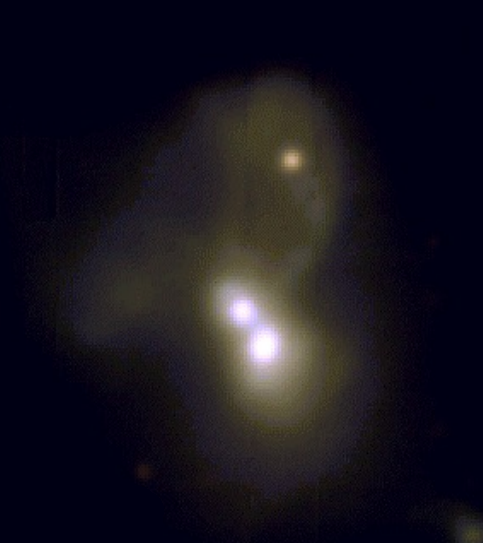Galaxies are constantly colliding, merging, and creating ever-larger structures. That’s true of the Milky Way, too. Our home galaxy has devoured multiple smaller galaxies in its past. And one day, about 4.5 billion years from now, the Milky Way will also merge with the nearby Andromeda Galaxy.
Astronomers study this cannibalistic cycle, called the hierarchical model of galaxy evolution, by catching distant galaxies in the act of smashing together. And when galaxies merge, so do their central supermassive black holes, which each weigh millions to billions of times the mass of the Sun. During this process, gas, dust, and stars dislodged by the collision can be either flung outward and away from the merging galaxies or inward toward their cores. In the latter case, the resulting influx of material can rapidly feed the supermassive black holes, forming bright, energetic accretion disks around them. That turns them into what astronomers call active galactic nuclei or AGN.
Now, researchers have spotted a triple galaxy merger — three separate galaxies slamming together at once — in which two of the three galaxies appear to sport an AGN. This sight is incredibly rare, and astronomers know of fewer than 10 such triple mergers with dual AGN. Two of the merging galaxies appear close together, with a third galaxy (this one a smaller dwarf galaxy) to their north.
Researchers think the dwarf may have already passed through the other two galaxies, disrupting all three as they swirl together. A tail of dust and gas connecting the dwarf to the other two is visible in images, which helps astronomers trace back the galaxies’ interactions thus far.
Mixed signals
The two larger, closer galaxies have central cores that are a mere 9,100 light-years apart. That’s only about one-third the Sun’s distance to the center of our Milky Way Galaxy. Curious about what was going on in these cores, astronomers used several observatories to peer at them in different wavelengths, including radio, infrared, optical, and X-ray light.
They discovered that the two close cores are each emitting bright optical light and X-rays indicating activity from an AGN. But one core shows stronger AGN signals than the other, while both are missing some key signs of AGN activity.
“Mergers are messy. Black holes start turning on, showing AGN behavior, and turn off again — and dust and gas can obscure what we see,” explained Johnathan Williams of the University of Maryland, who led the study, during a virtual press conference Monday at the 238th meeting of the American Astronomical Society. Such obscuring material, he said, could explain why the cores look like AGN at some wavelengths of light, but not others. He went on to add that better understanding this system can teach astronomers how and why AGN might turn on and off during a merger, such as when there is gas and dust in their vicinity.
End result
Exactly how supermassive black holes ultimately come together during a galaxy merger is still a bit of a mystery. But it’s one that researchers hope to soon solve, when future gravitational-wave observatories capable of “hearing” such events come online. “Knowing how often such mergers take place will help us know what to look for, and when we’re seeing something unexpected,” Williams said.
For now, astronomers can only study rare examples such as this in the hopes of disentangling them. In the case of this system, Williams said, models indicate the third core might eventually be ejected altogether, which could cause the two closer cores to merge faster than they might have otherwise. The team next plans to observe this triple merger with the Hubble Space Telescope to uncover more clues.
“This system combines an usual combination of features, some puzzling aspects, and the potential to answer a number of questions about AGN and galaxy mergers,” Williams concluded. “Work is ongoing and one thing is certain: More surprises lay in store.”










